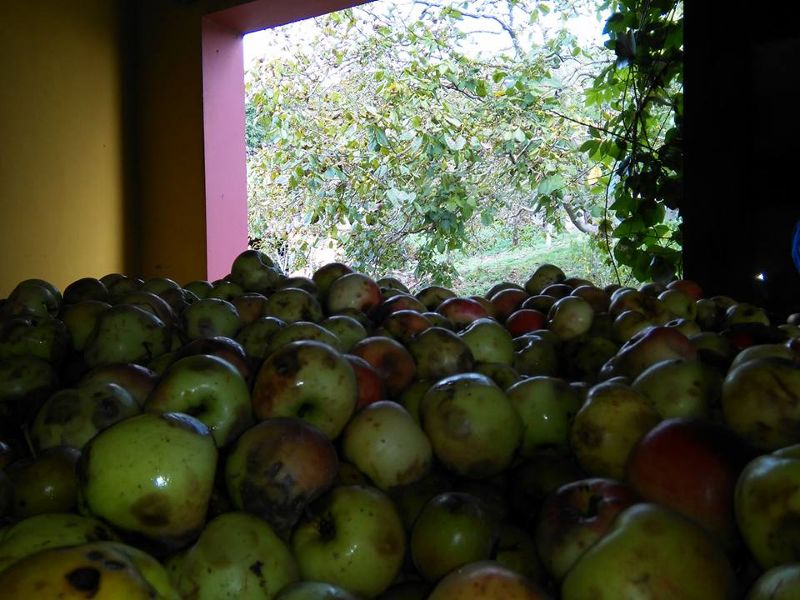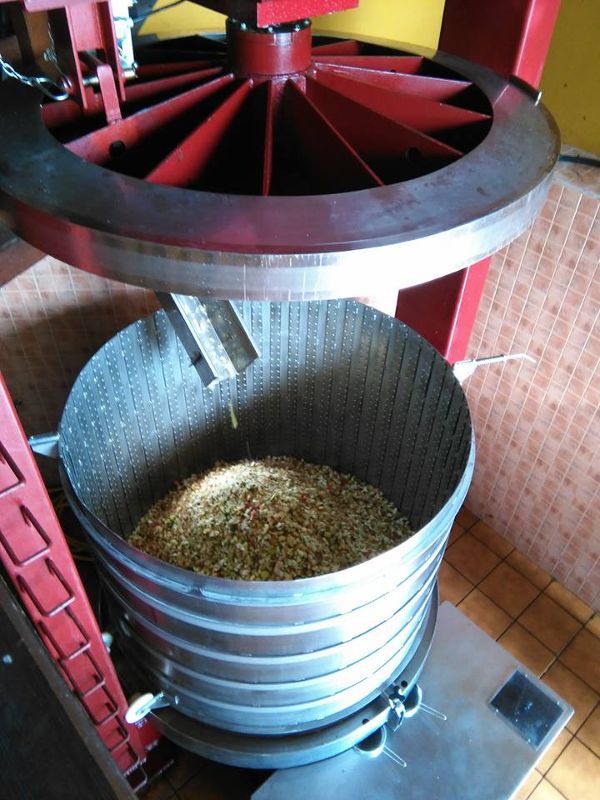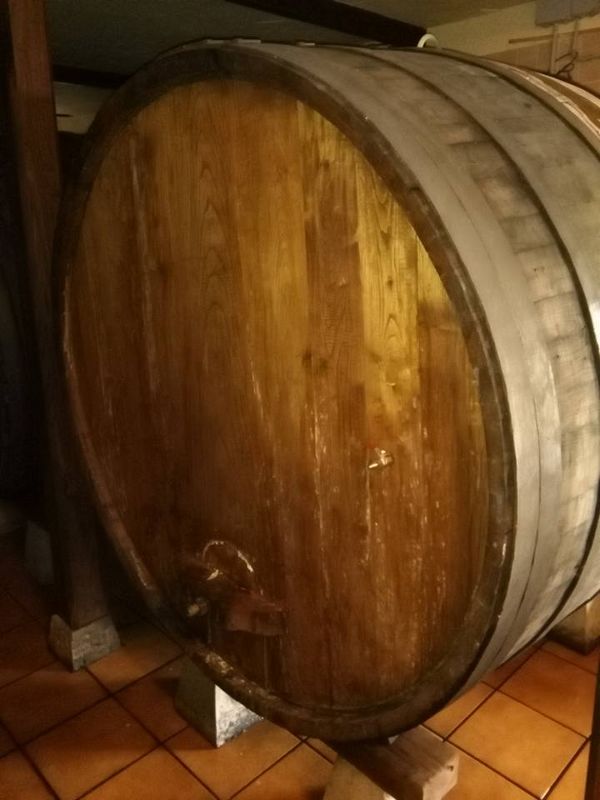
Welcome!
Be part of our community & join our international next generation forum now!
Categories
In this Discussion
- FloridaCracker November 2015
- grim November 2015
- Higgo November 2015
- marcus November 2015
- punkin November 2015
- Smaug November 2015
- Sunshine November 2015
- Unsensibel November 2015
- XEIP November 2015
Our Cider Production
As @crozdog would like to know more about our cider production, I will try to show some images (if I can) and some general explanations how we work.
We use several kinds of apples, we try a mix of 40% acidic apples, 25% semi acidic, 15% sweets apples, 15% bittersweet and 5% bitter (a little hard to get bitter apples):

Here we use a Cider press of about 4000 Kg of apples (it´s one of the smaller presses here):

We work very different like I see in UK or the North of Europe, we press, cut, press, cut .... several days. We put all that sweet cider in chestnut barrels of about 3000 liters and fermentation begins:

and wait for several months...............


1.jpg
800 x 600 - 86K


3.jpg
600 x 800 - 53K


2.jpg
600 x 800 - 88K
Tagged:

Comments
But the end is the best:
https://www.youtube.com/watch?v=m6CCLB7dOJU
well, the first thing I see is not so beautiful (how can I describe it else?) apples, this is something considered bad for distillation. But in cider it may be different, perhaps. Wild yeasts and all the other unwanted living stuff is the cause for off flavors in the ready product.
Now, come everyone and beat me...
StillDragon Europe - Your StillDragon® Distributor for Europe & the surrounding area
Maybe is different product adapted to taste than the taste adapted to the product. Here cider is the most consumed alcoholic beverage, no wine, no beer just cider. Our climatology isn´t very sunny,what really matters is the maturation,do not be fooled by their appearance, sugar is really important!! After the fermentation at the bottom of the barrels there are yeasts, bacteria and dead organisms. It´s bad for distillation, it gives soapy flavours. But I can say that the most important variable is not to use SO2. Here industrial producers can not bottle its entire production when its density commands , they use SO2 to preserve cider, and it´s really bad to distillate... we don´t use chemical products and this is good for the headache the day after!
if you want to distill the cider you will have to think about fermentation which will lead to only ferment the good apples under controlled factors with the yeast of your choice and as little wild yeasts as possible.
StillDragon Europe - Your StillDragon® Distributor for Europe & the surrounding area
I have to add: distilling apples is the bread and butter of Austrian farmers who do distilling. I know everyone used to do what the ancestors did. But times change and fortunately the knowledge about distilling did too.
StillDragon Europe - Your StillDragon® Distributor for Europe & the surrounding area
Looks great mate, nothing wrong with those apples. We pick apples by the side of the road most years and make about 100l of cider for home. Some gets distilled but mostly drunk as dry sparkling cider.
Our apples look a lot like that but have stings from the fruit fly. Fly stings don't seem to really develop into grubs round here, must be something in the apples they don't like which is funny cause even in chillis the grubs will develop.
We do cut the apples before juicing though because sometimes they get grubs in them from codling moth.
I love cider and it's a great product to make and so dependent on the apple stock you choose. You are spoilt for choosing with all those varieties, i had two cider varieties growing at home but lost them both, still have 8 vareties on two trees but they are all eating apples. So i takes what i gets. I only wish i could play with design like you can.
Do you use lactic acids to balance your ciders at all or just rely on a lactic ferment or purely on blending? I have a winemakers lactic mix that i've used in the past.
The money shot;
StillDragon Australia & New Zealand - Your StillDragon® Distributor for Australia & New Zealand
sorry Punkin, but between your apples and @XEIPs ones are worlds.
StillDragon Europe - Your StillDragon® Distributor for Europe & the surrounding area
Thats the thing with apples, beauty is not skin deep. Skin blemishes make no difference in my experience. B-)
I'd very happily use the apples in the top pic above the apples i use and if XEIP asked to swap i'd jump at the chance. They look different but his are much better quality.
StillDragon Australia & New Zealand - Your StillDragon® Distributor for Australia & New Zealand
I have to agree with @sunshine - visually, the apples from @XEIP look a lot bruised and starting too spoil. Are you guys giving them a good washing before pressing? What about the dark spots? Cutting them out?
4 tonnes a basket i doubt anyones cutting out a little bruising. #:-S
StillDragon Australia & New Zealand - Your StillDragon® Distributor for Australia & New Zealand
Damn, folks, its not like they are entering the apples in some beauty contest. It's cider. They look pretty fucking good to me.
we produce cider in the uk, machine picked apples are brused so not a problem. happy yeast is very important, dont stress it. we use a wine yeast and there is not enough nutrients in the juice so add 30/50g per 100 litres of juice, you will ferment in under 3weeks, allow the cider to drop bright then transfer it to tank/still
Coles Family Brewers - Est. 1999 - The Best Pub In Wales
I come from Somerset, South West England. This is the home of scrumpy cider. If you could see the types of apples that are used to make that you would think XEIPs apples were prime eating stock!
What is a good ambient temperature for Apple fermentation?
StillDragon North America - Your StillDragon® Distributor for North America
Apples are picked in the late summer through to autumn, so traditionally had a long fermentation over the winter. I'm really keen to hear @XEIP s experience on this one.
StillDragon Australia & New Zealand - Your StillDragon® Distributor for Australia & New Zealand
Months? You guys have some lazy yeast. I'm wondering what the temps are too, to stretch out for months (and not sit on a completed ferment, I'm guessing mid 60F).
Yep. A tied up tank limits annual profit is what I'm thinking.
StillDragon North America - Your StillDragon® Distributor for North America
if you aim for 15/17 celcius maximum of 20 this will ferment out in 2 weeks you need to use a wine yeast
Coles Family Brewers - Est. 1999 - The Best Pub In Wales
I agree with @Punkin, skin blemishes make no difference, most of it these skins are produced by the mottled, fungus Venturia inaequalus affects some varieties more than others but honestly that's not a big deal. The image you see is just before washing and selection, but these spots apples will not go away. Another different thing is apples with rotten parts, also those with Monilia frutigena, other undesirable fungus, those we do not want in our press. Cleanliness is something important to us
About yeasts: wild yeasts do their job, we can find Sacharomyces kuyveri and cerevisiae (with all its races like Bayanus etc.) and kloeeckera apiculata. We can find type Hanseniaspora uvarum and Candidas with its variations depending on the area, Pichia and Citeromyces too......... Total average load of yeasts in a traditional way is about 6x10000000 CFU / ML. In industrial processes, oxidative yeast are eliminated by the use of SO2, and they use commercial yeasts (generally the same as for wine). They need an homogeneous end. Here it is highly desired the cider with more aromatic complexity that give us the wild yeasts. Only if we have a stop with the fermentation, we use commercial yeasts, this is better than throwing everything but is not ideal for organic production. With the fermentation, the yeasts die maybe with increasing alcohol and Saccharomices c. just work.
@Punkin
About our apples, their maturity period is dependent on the varieties at the end of October, variety selection here is aimed at coinciding with the beginning of cold days, climate change will be a future problem... At what experiences do you mean? fermentation process? There are really two fermentations, the first is called tumultuous which takes about 12-15 days and the second is called malolactic or complementary lasting several months.
@Smaug Here the barrels should be about 10-13 ° C, more than 14 or 15 ºC is a dangerous thing....
Excellent mate. Your experience ties in with my small scale experience and i like to leave my cider ferments over the winter before packaging.
I really like that you are doing a traditional wild yeast fermentation, i have never been brave enough and tend to use either a red wine yeast that creates a lot of flavour or a champagne yeast to take it very dry.
I'm really interested to hear more and see more pictures of your cidery, apples and the cidermaking process fascinates me. Please keep feeding me information and pictures.
StillDragon Australia & New Zealand - Your StillDragon® Distributor for Australia & New Zealand
@Punkin, I would know that variable causes you decide packaging, taste? Do you monitor the density of your cider? very sweet cider with many polyphenols make life difficult for the yeast! Some experience with ice cider???
Related, I came across this catalog from Scott Labs the other day and thought it was incredibly insightful from the cider angle. It's a product catalog but really nicely done with some good snippets and articles.
Cider Handbook 2014-2015 Scott Laboratories (PDF)
Many thanks @grim, everything about this is interesting, I will translate and study. :-B
I wait for it to drop bright Xeip. Then i wait till i can be bothered, by that time it has dropped below 1.00. :D
StillDragon Australia & New Zealand - Your StillDragon® Distributor for Australia & New Zealand